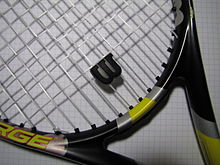Vibration damper
A vibration damper , also known as a vibration damper (absorber), is a component that dampens the movements of vibrating vehicles, devices, machines or sports equipment .
Automotive industry
In the automotive industry, vibration dampers are used to filter unwanted resonances from the vehicle frame so that they do not get into the passenger compartment from the engine compartment. They are usually made of silicone and ensure constant damping properties over a wide temperature range.
Industrial equipment and machines
In industry, vibration dampers are mainly used to protect heavy machines or devices against undesired vibrations that arise from the operation of the machines and that can impair, damage or, in extreme cases, even destroy the function of the machines being operated.
Household appliances and machines
In household appliances and machines, vibration dampers are primarily used to dampen the vibrations and resonances caused by the high rotational speeds of the devices. These are z. B. integrated in feet and thus prevent z. B. in washing machines and tumble dryers slipping of the devices due to the vibrations of the device generated on the operating side.
Sports equipment
In sports equipment, e.g. B. Squash or tennis rackets , vibration dampers are attached to the lower side strands. They are mostly small, hinged rubber or hard rubber elements that are attached for cushioning. By using a vibration damper, the vibration of the string and thus the noise when hitting the ball is greatly reduced. Installed vibration dampers may only be mounted under the lowest cross string and touch a maximum of 3 strings.
See also
Individual evidence
- ↑ Damping & Insulating. Retrieved May 11, 2020 .
- ↑ Tennis rules of the International Tennis Federation (ITF), p.76, rule 4, case 3, p.91 Annex II point d (PDF; 123 kB)
